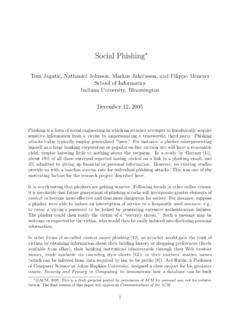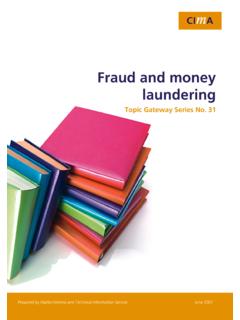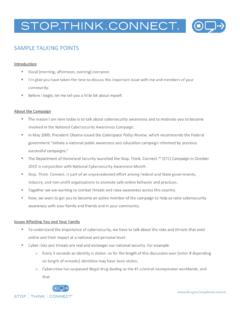Transcription of and decision making phishing attacks
1 How human behavior and decision making expose users to phishing attacksBY INA WANCA AND ASHLEY CANNONA pproximately 95% of cyber attacks and events involve preventable human error and behavior use phishing and social engineering to defeat data and system security by exploiting weaknesses in decision making and human behavior. whY behavior matters in cYbersecuritYThis number suggests that Internet users are vulnerable, independently of platforms and software. As behavioral scientists have argued, psychology plays an important role in providing answers to why individuals engage in risky cybersecurity Therefore, there are cybersecurity areas and problems where behavioral science could be applied and could have a positive impact on users cybersecurity habits.
2 This report asserts that cybersecurity behavior relies on decision making , and, therefore, Internet users must be aware of the ways their behaviors and decision making expose them to Crime Commission of New York City How Human Behavior and decision making Expose Users to phishing attacks 1 phishing is a form of fraud where cybercriminals attempt to collect information from a user by posing as a legitimate source ( , financial institution) to steal personal information, money, financial data, trade secrets, or gain access to computer systems, among other phishing attacks , cybercriminals utilize manipulation and deception to trick users into providing the requested information ( , social engineering).
3 Such tactics make it difficult for users to accurately identify fraudulent emails. In fact, only 3% of the more than 19,000 people from around the world that took Intel Security s 2015 phishing Quiz identified every phishing email correctly; and 80% of quiz takers incorrectly identified at least one phishing Given that it only takes one email to fall victim to a cybercriminal s attack, it is important for users to understand: the potential impacts on victims; the tactics used in phishing scams; and behavior modifications that users can implement to protect themselves and their families, friends, schools and is phishing ?Citizens Crime Commission of New York City How Human Behavior and decision making Expose Users to phishing attacks 2 Cybercriminals may use phishing scams to steal credentials ( , usernames, pass-words) and other personal information to gain access to personal or work accounts to steal money, financial or health data, trade secrets, or other sensitive information, or to carry out other crimes, such as identity theft, corporate espionage, or extortion, among other The information obtained through phishing scams can also lead to further victim-ization.
4 For example, if a user s personal information ( , name, address, telephone number, email account) is posted online, other criminals may use this information to commit other crimes against the victim ( , stalking, harassment, burglary).6 Victims may even be at risk of becoming suspects in crimes committed by a criminal using their identity or credentials. For example, the cybercriminal may use the victim s credentials to steal money from their employer via an illegal wire Moreover, both the personal and professional lives of victims of cybercrimes can be impacted in a wide range of ways, such as: lost time; trauma; financial loss; social consequences; business consequences; and lost phishing impacts YouCitizens Crime Commission of New York City How Human Behavior and decision making Expose Users to phishing attacks 3 Recovering from a phishing attack can be confusing, time consuming, and generally inconvenient for victims.
5 Depending on the type of damage caused by a phishing attack, victims can spend anywhere from a few hours to many months or years resolving the associated timePhishing attacks can cause significant emotional distress ( , denial, loss of trust, frustration, fear, anger, powerlessness, helplessness, embarrassment, depression, sleep disturbances).9 Some theorize that cybercrime victimization, such as identity theft, can be more harmful to victims than crimes like property theft because one can replace property, but it is not possible to acquire a new Further, phishing victims can experience secondary victimization by others who blame the victim for falling for the traumaCitizens Crime Commission of New York City How Human Behavior and decision making Expose Users to phishing attacks 4 Victims can incur both direct ( , value of goods, services, or cash obtained) and indirect ( , legal fees, bounced checks, postage) financial loss resulting from phishing attacks .
6 For example, in 2014, victims of identity theft reported an average combined direct and indirect loss of $1, In addition, the employers of phishing victims can experience financial losses related to decreased productivity (see below), business disruption, isolating malware and credential compromises, and the cost of data breaches. Researchers estimate that the total annual cost of phishing for the average 10,000-employee company is $ LossVictimization can cause strain on personal and family relationships and reputational damage. For example, if cybercriminals gain access to a victim s email, they can uncover information about personal relationships or embarrassing photos or videos that may be leaked to the Family or friends could also become the targets of cybercriminals.
7 SociaL conseQuencesCitizens Crime Commission of New York City How Human Behavior and decision making Expose Users to phishing attacks 5 COPYRIGHTPATENTTRADEMARKTRADE SECRETSINTELLECTUALPROPERTYAT RISK FROM PHISHINGBoth intellectual property and customer data can be at risk when a phishing attack occurs. In addition to financial loss, a phishing attack can damage the reputation and credibility of a business. Consumers may lose trust in the business, which can lead the company to lose its customer Moreover, cyber-espionage typically begins with phishing when employees interact with malicious attachments or follow links to malicious websites. This initial attack allows cybercriminals to gain backdoor access and install malware on computers/devices to further penetrate a system Given that it can take months to years to detect a network compromise and it only takes minutes to steal information off a network,17 cybercriminals can have long periods of undetected access to trade secrets that can hinder business conseQuencesThe time it takes to recover from a phishing attack and the trauma inflicted can result in decreased employee productivity.
8 It is estimated that non-IT employees spend an average of hours per year dealing with phishing The related cost of productivity losses is estimated to be $ million accounting for 48% of the total organizational Further, productivity can also be lost in preventing phishing attacks , as employees spend time determining if an email is fraudulent. Lost productivitYCitizens Crime Commission of New York City How Human Behavior and decision making Expose Users to phishing attacks 6authoritYResearch has found that people tend to comply with requests from authority Thus, phishing scams claim to be from a trusted source by using a corporate logo or name as the sender to attempt to create legitimacy and time pressurePhishing scams may request a rapid response to pressure users to act quickly, and decrease the time users have to uncover the scams often use a formal tone with a combination of persuasive and polite statements to influence user decision making .
9 Examples include: polite salutations and closures ( , Dear, Thank you, Kind regards); trigger words ( , alert, warning, attention); and persuasion ( , upon verification, restrictions will be removed).23whY is phishing a successFuL trick? phishing attacks often rely on a combination of tactics that are known to influence human decision making , such as:Figure 1: phishing tacticsNYC BANK FRAUD DEPARTMENTFear / Tone:Trigger WordsSalient pieces ofinformation withpersonalizationTone: PersuasiveTime Pressure / FearTrustedAuthorityTone: PoliteCitizens Crime Commission of New York City How Human Behavior and decision making Expose Users to phishing attacks 7saLient pieces oF inFormationPhishing scams may include a personalized message or salient pieces of information ( , primary account contact) to persuade a user that the email is In targeted phishing attacks ( , spear- phishing ), cybercriminals build a target profile based on public information ( , employer websites, social media) to craft more authentic appearing messages.
10 By acquiring key insider knowledge ( , job functions, work relationships), cybercriminals can increase the likelihood of a successful scams may prey on users fear of something to manipulate them into acting. Cybercriminals may invoke fear by making threats ( , account restrictions) or leveraging current events ( , natural disasters, health epidemics, economic concerns, political elections, holidays).25 (see Case 1)whY is phishing a successFuL trick?cYbercriminaLs expLoit FearIn 2009, cybercriminals sent emails that appeared to be from the Center for Disease Control and Prevention stating that a state vaccination program was implemented to combat the swine flu and requested that users create a personal vaccination profile by clicking a link that appeared to be the website and enter their personal 1:Citizens Crime Commission of New York City How Human Behavior and decision making Expose Users to phishing attacks 8In general, phishing attacks rely on a combination of behavior factors to influence users.










